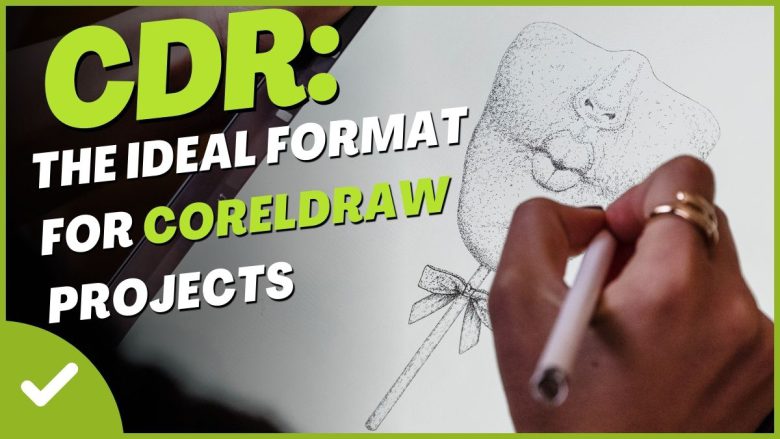
Choosing the right file format for your graphic design projects is important. It can greatly affect their efficiency and quality. For CorelDRAW users, the CDR file format is the clear choice. CDR files are designed specifically for CorelDRAW. They have many features and benefits. These make them ideal for creating, editing, and sharing vector graphics. This blog post discusses why CDR is the best format for CorelDRAW projects. It covers its special features, compatibility, versatility, and benefits for designers.
What is a CDR File?
A CDR file is a type of vector graphics file. Corel Corporation created it. It is the default file format for CorelDRAW, a popular vector graphics editor. CDR stores design elements, such as shapes, lines, text, and colors, as math. This allows them to be scaled without losing quality. This makes CDR files ideal for making high-quality graphics. These include logos, illustrations, and print designs.
1. Native Compatibility with CorelDRAW
One of the primary benefits of the CDR format is its native compatibility with CorelDRAW. CDR files are a proprietary format. Corel Corporation developed them to work smoothly in CorelDRAW. This ensures that a design’s features, effects, and properties are saved in CDR format. They are saved accurately.
Using CDR files in CorelDRAW lets designers use the software’s features fully. These features include advanced vector editing tools, color management, and layout options. This native compatibility eliminates the need for conversions. Conversions can cause data loss or formatting issues.
2. Lossless Quality and Scalability
CDR files are vector-based. They contain graphical elements as math formulas, not pixels. This approach uses vectors. It ensures that graphics can be scaled to any size while maintaining quality. You may need a small icon or a large billboard design. CDR files keep sharpness and clarity at any resolution.
This lossless quality is key for print designs. They need high resolution for pro results. Designers can use the CDR format to make intricate graphics. The graphics appear crisp and clear when printed, no matter their size.
3. Rich Feature Support
CorelDRAW has many features and tools. They work fully with the CDR format. These include advanced drawing tools. They have vector shapes, gradients, transparency, and complex paths. CDR files can store layers, text, and metadata. This allows for a more flexible design environment.
The CDR format supports non-destructive editing. It lets designers experiment with effects and adjustments. They can do this without permanently changing the original design. This feature is vital for ensuring project integrity. It allows for iterative changes during the design process.
4. Interoperability with Other Formats
CDR is CorelDRAW’s native format. But, the software can also export and import many other file formats. This interoperability lets you easily share designs. You can share them with clients or colleagues who may use different software. CorelDRAW supports exporting CDR files to popular formats. These formats include PDF, SVG, EPS, AI, and PNG, among others.
This flexibility ensures that designers can work well with others. It works regardless of the software they use. For example, a designer can start a project in CorelDRAW. They can then save it as a CDR file for future work. Finally, they can export it as a PDF for client review or an SVG for web use.
5. Comprehensive Design Environment
The CDR format benefits from being a part of the CorelDRAW Graphics Suite. The suite is a full set of design tools and applications. In addition to CorelDRAW, the suite includes Corel PHOTO-PAINT for image editing. It also has Corel Font Manager for font organization and other design tools.
Using CDR files in this setup lets designers move smoothly between tasks. These tasks include vector drawing, photo editing, and typography. This workflow boosts productivity. It ensures that all parts of a project are managed well.
6. Robust Color Management
Color accuracy is an important aspect of graphic design, particularly in print projects. The CDR format works with CorelDRAW’s strong color system. It makes sure that colors look right on all devices and media. CorelDRAW supports many color models. These include RGB, CMYK, and spot colors. It also has tools for precise color calibration and profiling.
This amount of control over color is critical for pro results. It’s key when using brand colors and print specs. Designers can use CDR files to ensure that their colors appear as intended in the final output.
7. Version Control and Compatibility
CorelDRAW has been around for decades, and the CDR format has evolved with it. Newer CorelDRAW versions have more features and improvements. But, the software still works with older CDR files. This ensures that designers can open and edit files from older CorelDRAW versions. They can do this without difficulty.
Version control is another key consideration. It is crucial for complex projects. They need multiple revisions. CDR supports incremental saving. This allows designers to track different versions of a project. They can revert to earlier stages as needed. This feature is very useful. It helps keep an organized workflow and manage big design projects.
8. Community and Support
Many people use CorelDRAW and the CDR format. They have a big user community. It offers many resources, tutorials, and forums for designers. This community support is helped by Corel Corporation’s official resources. These include user manuals, video tutorials, and customer support.
Access to a strong support network helps new and experienced designers. Do you need help with a tool? Or want to learn advanced techniques? The CorelDRAW community and official resources can guide and assist you.
Conclusion
In short, the CDR format is great for CorelDRAW projects. It is native, lossless, and supports many features. It works well with other formats. It has a full design environment. It has strong color management, version control, and a big community. These benefits make CDR files adaptable and dependable. They are a good option for graphic designers. They work on many projects, from simple to complex.
Designers can use the CDR format with CorelDRAW. It lets them fully use CorelDRAW’s abilities. This ensures that they can create and edit with precision and flexibility. The CDR format will help both designers and hobbyists. It improves workflow and lets you easily make high-quality, scalable graphics.


